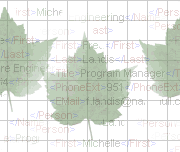
Home >
Dataleaf Technologies, Inc: HR System migration, Archiving, Analysis, Modeling, Interim HRIS
Interim Strategies
The price tag for Implementing -- just implementing -- a new HRIS system may be several millions of dollars.

For this reason it is sometimes helpful to augment the basic migration plan with well-chosen interim strategies. Some interim strategies we have explored with clients are the following:
- When data unification is an issue, the client may implement reporting functions with data unification and data quality features, as well as rich export capabilities: DXML, Excel, One-field reporting, change-only, etc.
- When an organization is structurally in transition, the client may benefit from an ancillary data mart for reporting and retrieval, with data unification, rich retrieval options, data quality analysis, org chart features, etc.
- Additional persistent data (such as a 'second rollup' for GL or a secondary organizational structure -- outgoing or incoming) can be retained outside legacy systems
- When an existing automated system has begun to lose its usefulness due to data element drift or data corruption, but no mechanisms exist within the system to support data cleanup, the user may benefit from mounting a data quality project enabled by modern data conversion DQ technology, just as if system migration were imminent. Dataleaf can supply such DQ technology, developed in support of our system migration contracts. It is inexpensive, systematic, and auditable.
- When changes are taking
place, clients may benefit from standard temporary software connections
between old and new components. Requirements in this area are really
quite predictable: Time and Attendance, Payroll, Core HR, Benefits,
Third Party Admin -- these are the blocks that need temporary,
flexible connections -- strong but not over-automated.
temporary, transitional HRIS...
Some organizations overlook the ease with which interim and transitional mechanisms can be implemented.
It may be surprisingly easy to achieve temporary integration goals quickly, and -- at the same time -- to facilitate long term enterprise level projects already in progress.
Dataleaf Services...
- Auto Data Mapping
- Data Conversion
- Data Repair
- Record Keeping
- Employee Survey
- Financial Modeling
- HR Modeling
- Interim Strategies
- Parallel Testing

